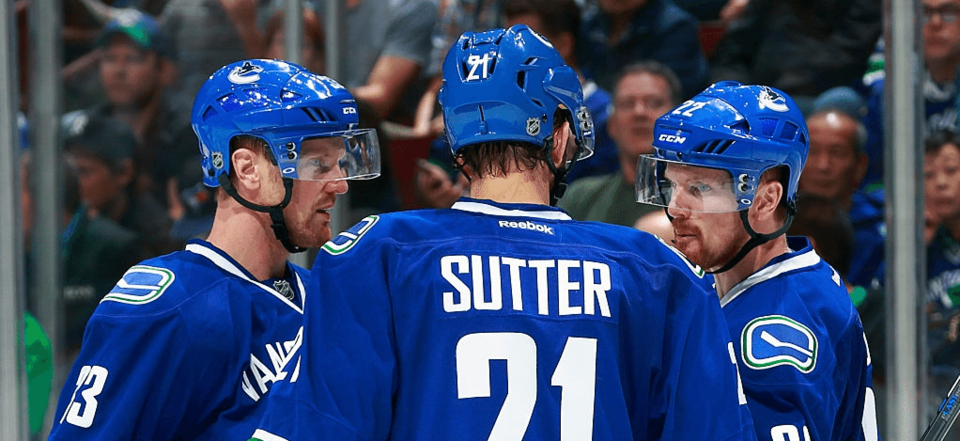For the second time in as many seasons, Brandon Sutter has ended up on the wing with Daniel and Henrik Sedin on the Canucks’ first line. That’s not the role anybody envisioned when the Canucks acquired him.
Sutter is a centre. He has always been a centre. For the Canucks, he was envisioned as a shutdown defensive centre when he was acquired, potentially with some offensive ability that was untapped while playing behind Sidney Crosby and Evgeni Malkin in Pittsburgh. Instead, he’s spent about a quarter of his time with the Canucks as a scoring winger.
It’s certainly not a bad thing if Sutter winds up as a first-line winger. He’s being paid like a top-six forward and he’s not going to be the Canucks’ second-line centre, so playing on the Sedins’ wing is the only way he’s going to be in the top six.
(And if you disagree and think Sutter is the Canucks’ second-line centre, feel free to explain in the comments how the Canucks’ leading scorer, both this season and in the calendar year of 2016, should be on the third line.)
It’s certainly not the first time a primarily defensive player has fit nicely with the Sedins: Alex Burrows and Jannik Hansen were third-line grinders and penalty kill specialists before they suddenly became first-line scorers.
Sutter does have some goalscoring history, putting up 21 goals as a sophomore with the Hurricanes in 2009-10 and again in his last year with the Penguins in 2014-15. Sutter was on pace for another 21 goals last year with the Canucks before injuries derailed his season and he’s on the same pace this season.
He also fits the profile of the type of winger the Canucks have been trying to find for the Sedins for years: big, right-handed shot, with a great release on his wrist shot and a willingness to play a gritty, physical game. Guys like Steve Bernier, Taylor Pyatt, and Zack Kassian are the types of big, power forward that the Canucks thought were the right fit.
And yet it’s hard to shake the feeling that Sutter and the Sedins just shouldn’t work.
The Sedins do the majority of their scoring (and assisting) off the cycle. Sutter does most of his scoring off the rush. Together, , but it doesn’t seem like they should put up points.
This is backed up by Sutter’s underlying possession numbers. Sutter is sometimes described as having a 200-foot game, but he really doesn’t. The impact of his game is almost solely felt in the defensive end of the rink, where he does have a tangible impact on reducing shots against. The problem is that he reduces shots for as well and has historically struggled to keep the puck in the offensive zone for any length of time.
While Sutter may help their puck possession game by taking faceoffs on his strong side, overall he has a negative impact. While he seems like the type of player that should be good at grinding out puck battles below the goal line and contributing to the cycle, that hasn’t worked out in practice by the eye test and the numbers back it up.
Sutter has played just over 111 minutes with both Sedins. In that time, the trio has posted a Corsi% of 46.0%, ie. the Canucks take 46.0% of the total shot attempts when they are on the ice. That’s really not a good number. Apart from Sutter, the Sedins have both been above 50.0% in that time.
With Hansen over the last couple season, the Sedins have posted a Corsi% of 52.0%. With Eriksson this season, the Sedins have a Corsi% of 58.8%. Sutter might be working with them for the short term, but long term you have to think one of Hansen or Eriksson would be the best fit.
The players that have worked best with the Sedins haven’t been big power forwards, but smaller, quicker, hard-forechecking forwards like Burrows and Hansen. If not them, slighter, more skilled players like Mikael Samuelsson and Pavol Demitra have found success alongside the Sedins as well.
(It does make me wonder if a hybrid approach would work: a big, right-handed power forward with a great shot who is also fast and forechecks hard. If only the Canucks had drafted just such a player with the sixth overall pick in 2014.)
But, while injuries linger and litter the lineup with AHL call-ups, Sutter will serve as the Sedins’ sniper. Best case scenario, his ability to score off the rush will give the Sedins a new offensive weapon and the Sedins’ cycle will start to rub off on Sutter and he’ll improve his play along the boards.
Ìý
*All numbers via stats.hockeyanalysis.com and puckalytics.com



